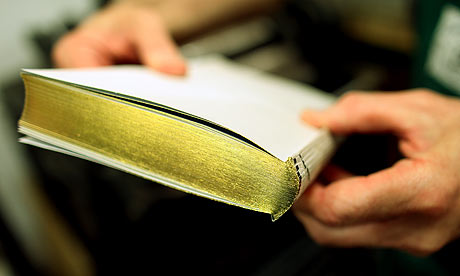
What is the point of dustjackets? The clue can't be in the name: on the shelf, the most dust-prone part of a book is the top, which a jacket doesn't cover (these days, anyway). Decoratively, too, they are a recipe for disappointment. Bring home your expensive new hardback, lift up its gorgeous plumage, and underneath – in the UK at least – you're liable to find rough-textured and drably covered board, with the only graphic element a cruder reproduction of the lettering on the spine of the jacket. In America, land of the deckle edge, your chances of a pleasant surprise are greater; but the jacket remains an unnecessary and vulnerable encumbrance. That, at least, is how it has always seemed to me – and some in the book trade appear to be reaching the same conclusion.
Jacketless hardbacks with cover art printed on them (the technical term is "casewrapped") were once a format reserved for rough environments. It was the style for set texts to be handed down across generations of schoolchildren, and workshop manuals to be kept within reach of greasy fingers. Now, however, it seems to be becoming an increasingly popular option for literary fiction.
The first one I noticed, a couple of years ago, was Sharp Teeth, Toby Barlow's strange free-verse werewolf novel, which came in a pleasingly double-textured jacketless hardback for £12.99. This is one intelligent use of a casewrap – to create something cheaper than the traditional hardback, which can be a difficult sell with all but the biggest-name novelists, but more substantial (and perhaps more expensive) than one of those anticlimactic "paperback originals". A similar treatment was recently given to Dan Rhodes's Little Hands Clapping, and Bloomsbury are pushing something they call a "bendyback": a casewrapped hardback with thin boards, again priced between a traditional hardback and a paperback original. Their prototype is Jon McGregor's Even the Dogs.
But a casewrap is not always a signal of something less costly. Andrea Levy's new novel, The Long Song, has a full hardback price (£18.99), but goes jacketless to offer a seductive imitation of an Edwardian children's classic. The hardback of Changing My Mind, Zadie Smith's essay collection, appears to have lost its jacket for the opposite reason – in order to look contemporary, stripped-down and iconoclastic – and nonetheless costs £20.
When I asked the Bookseller's Benedicte Page about all this, she reckoned it was part of a wider race among publishers for "distinctive and different ways to publish all their titles to increase their 'shelf appeal', as there is so much competition for space and attention in the bookshops". An emphasis on the printed book as an object - "a beautiful and special and distinctive object" - could also help it keep "a separate market in the age of the ebook".
A means of producing such distinction that involves stripping away an extra – rather than bolting on another one, at additional cost – seems likely only to become more popular.

